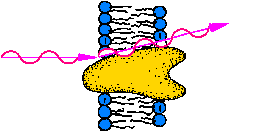 |
Membrane Pharmacy Structure Dynamics
Research group : Priv.Doz. Dr.
Thomas Nawroth
Science
|
Science - Investigation of the
structure-function relation of proteins and membranes
The scientific work of the MPSD group follows an interdisciplinary
concept : The investigation of molecular motions in biological systems
requires the parallel application of biophysics, biochemistry, molecular
biology and physics, especially structure investigations. This is the concept
of "biophysical chemistry", which is in detail explained at the MPSD_concept
page. The investigations are in part done locally in the MPSD group,
a part is done in several collaborations (open group concept). Thus the
work is done in parallel with the following complementary methods:
Structural biology studies
Biological activity studies
Biophysical studies
Biochemical preparations
Chemical synthesis
Structural
biology studies
- structure investigation of proteins in solution, e.g. by neutron- and
X-ray small angle scattering, EXAFS / XANES:
.. F1ATPase from Micrococcus luteus
.. ATP-synthase from Rhodospirillum rubrum and Micrococcus
luteus in detergent solution (TDOC)
.. monomeric Bacteriorhodopsin from Halobacterium salinarium
(halobium) in detergent solution (TDOC)
.. Cytochrome oxidase from Micrococcus luteus in detergent
solution (TDOC)
- structure investigation of lipid membranes (liposomes) during energization
(pH-jump) by time resolved neutron scattering
- structure investigation of working F1ATPase during ATP
hydrolysis by time resolved X-ray small angle scattering (TR-SAXS after
ATP addition ().
- time resolved XANES / EXAFS of metal proteins for detection of fast
motions
- freeze fracture electron microscopy of liposomes (with and without
protein) and native membrane preparations.
Biological
activity studies
.- estimation of the three coupled activities of ATP-synthase: proton-transport,
ATP-synthesis
(F16) and ATP-hydrolysis. Only the
estimation of the functional coupling of these three activities can exclude
artefacts, e.g. by structural demage during protein isolation. Those studuies
have been done with ATP-synthases from beef heart mitochondria (F17,
F22),
Micrococcus
luteus (F23,
F18)
and Rhodospirillum rubrum (F3).
- estimation of ATP hydrolysis of the F1-fragment (F1ATPase)
of ATP-synthase, e.g. from Micrococcus luteus (F8,
F18,
F20)
- estimation of proton related redox activities of cytochrome
oxidoreductases, e.g. Ubiquinol-oxidase and Cytochrome-c oxidase from Micrococcus
luteus (F19) or Cytochrome-o complex
from Rhodospirillum rubrum (F12).
- estimation of proton transport across membranes under
stress, e.g. after energization by a pH-jump using a stopped flow rapid
mixing device or flash photolysis of caged acids (T15,
T20).
- Photolabeling of proteins and membranes, e.g. with fluorescent
photoaffinity labels (F15) or metal labels
Biophysical
studies
- spectroscopy of metal proteins (terminal oxidases in respiration), time
resolved spectroscopy
- redox titration of oxiddo-reductases
- time resolved estimation of proton fluxes by light spectroscopy of
dye entrapped liposomes after a pH-jump (stopped flow addition of acid,
acid generation by caged acids).
- BLM (black lipid membrane, planar lipid membrane) electrophysiological
investigations, especially with membrane proteins (ATP-synthase) and lipid
analogs / pharmaceutical compounds
- EPR study of terminal oxidase
Biochemical
preparations
The biochemical preparations are the prerequisite of any other studies.
Especially the time resolved structure investigation
of working proteins require a very high quality of the isolated
proteins: highly pure (>98%), native (fully functional) and kinetically
homogenous preparations, even with the difficult integral membrane proteins.
As presented in T20 the required knowledge
was obtained by the MPSD group in more than 50 "man-years" work (see thesis
list). In some cases the precedures were recently developed to the
biotechnical level for structural biology investigations
(up to 200 mg F1ATPase, ATP-synthase and terminal oxidases from
Micrococcus
luteus, monomeric Bacteriorhodopsin from Halobacterium salinarium).
Due to the complex properties and molecular interactions, the scientific
work with membrane proteins requires six steps
for the deliviry of the scientific objects:
- growth of cells, if required after genetic manipulation: In the MPSD
group we grow the bacteria: Micrococcus luteus, Rhodospirillum
rubrum, Halobacterium salinarium (S9 from D. Oesterheldt).
- isolation of membranes, if required from organelles (eucariotes,
e.g. beef heart mitochondria)
- isolation and purification of proteins, in case of membrane proteins
with detergents
- isolation and purification of lipids, if required chemical (semi)synthesis
- preparation of model membranes from lipids (liposomes, BLM)
- reconstitution of membrane proteins into model membranes (liposomes)
Chemical
synthesis
- synthesis of caged acids (proton) for the generation of a membrane
proton potential (energization) by a pH-jump after flash illumination.
This enables us to experiments with membrane energization without any "helper
protein" (e.g. Bacteriorhodopsin) or shear stress (stopped-flow), as required
for time resolved structure and function investigations of membranes and
membrane proteins after energization by a pH-jump. A recent application
is the time resolved neutron scattering of liposomes, by which a proton
potential dependence of the lipid membrane structure
was detected.
- synthesis of caged nucleotides, caged-ATP, caged-ADP,
and HPLC purification for time resolved structure and function investigations
with flash-photolysis activation of the biological system.
- synthesis of fluorescent and coloured hydrophobic photoaffinity
labels (F15, T20)
- synthesis of metal labels for proteins , lipids and polymers:
quasicovalent chelate labels bearing heavy metals, e.g.Europium (Eu), Terbium
(Tb), Gadolinium (Gd), Samarium (Sm), Iron (Fe), Uranium (U). These are
use for X-ray structure investigations (ASAXS, MAD phasing, EXAFS / XANES)
and fluorescence studies (in case of Eu the fluorescence is a strong phosphorescence
of 0.5 ms decay !).
email to: nawroth@MPSD.de
update : 15.10.2012

